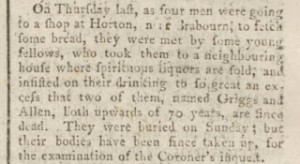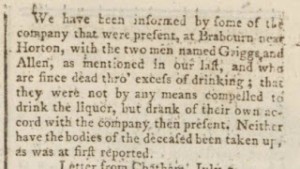This is the second in my series of posts about the perils and pitfalls of relying on other peoples’ online family trees.
In the last post I commented about some of the issues to be aware of in relation to dates. I will now look at some of the dangers signs in regard to places.
- No places stated for an event. If a record has been found that proves a piece of information, it will almost always show where the event had happened. For example, to know that someone was baptised on a particular date, the source is probably a baptism register for a particular church, and therefore, it should follow that we know where the baptism took place. There are always exceptions (for example, a family bible might give dates but not places), but these are likely to be the minority of pieces of data on a family tree. If an online tree you have found generally only has dates and no (or very few) places recorded on it, the chances are that the researcher hasn’t diligently gathered the information, or at least not documented it, and so be dubious. They may have just copied the information from elsewhere.
- The people move about-a lot! Our ancestors did migrate and move around, and sometimes by long distances, although short migration, of perhaps a few miles, was far more normal. I have seen examples of online trees where someone seemed to dart around the country, with each child being born in a different part of the country, hundreds of miles apart. Whilst this might have been a true reflection, more often than not, it is a case of mistaken identity, and many different people with the same name have been merged as the same person in the tree. If you see a lot of movement, try and as yourself: “How does the researcher know that all these are the same person?”
- The records don’t survive, or haven’t been indexed. It isn’t easy to detect this on an online family tree. It is quite common to find that the places in a family tree will suddenly jump from a parish where the family had been for a while to somewhere else. The reason being that the researcher failed to find any earlier records of the family in that place. This could quite legitimately be the case, although there are three common other explanations…
- The records don’t survive earlier for that place. Parish registers are one of the main sources for baptisms, marriages, and burials, but their survival varies for each parish. If the records haven’t survived, your family won’t appear to exist, but could have been in that place all along.
- The records haven’t been indexed any earlier. They may still exist in an archive where they have been deposited, but a researcher only working online hasn’t found them simply because the records aren’t online.
- The name doesn’t appear in quite the way you expect it to, for example, a spelling variation. In s recent project for a client, I was researching their Elstrop ancestors. However, in earlier records, before about 1820, the name was recorded as Healstrop. Phonetically the names are very similar, an H often being nearly silent in English, but the computer algorithms use by online family data providers weren’t smart enough to consider these to be the same, so searching for Elstrop didn’t show up results for Healstrop. This could have lead an inexperienced researcher to think the family weren’t there. By searching the original records, page by page, reading the original handwriting, name variations like this can be detected, and the family progressed back further.

